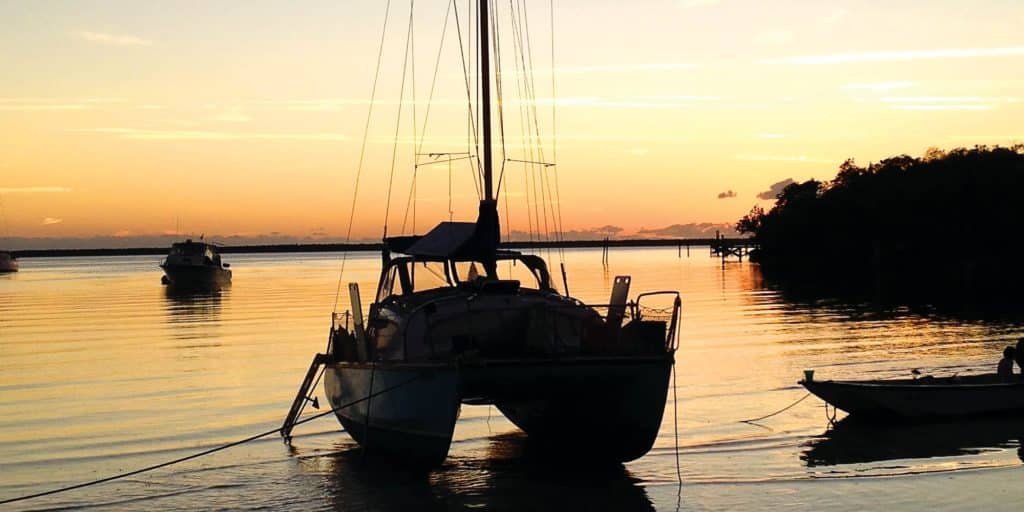
Shoal-water anchored in the Ten Thousand Islands on the west coast of Florida, with the sky burning orange and the mangroves black and low. The last of the day’s light falls tangled over the water. A half-submerged hull of a fiberglass flats boat looms in the shadows. I turn my cellphone on to check it, as I have each morning and each evening. This time I get a message. It’s my friend Brian. He’s the one who owns the boat I’m standing on. His voice comes as flat as the water. He tells me his wife, Abby, 36 years old and a mother of two, just died. He tells me he’ll meet me in the Bahamas.
I picture Brian’s wife as I’d last seen her, up in northern Michigan, tall and beautiful and smiling as their two kids climbed her legs. I stare at the mangroves, the sunken fiberglass hull, the burning sky. I hang up the phone and go back to the cockpit, where Josh and Shannon are drinking beer and cooking dinner.
Four weeks earlier, I’d been iced-in at a marina in Portland, Maine, where I lived aboard my Tartan 34C, when Brian had called and said things didn’t look good for Abby. She wasn’t going to make it to the Bahamas. It would just be him and the kids, he said, and they wanted out of Michigan as soon as possible. He wanted to scoop the children up, set them on a plane, then step off the plane in the Bahamas.
I’d offered to drive out to Traverse City to be with him, help where I could, but he’d said, “Just get my boat to the Bahamas. We’ll need it there when this is over.”
I’d known Abby had been in bad shape lately, but she’d been in bad shape before: She’d fought various cancers since her late 20s. She’d survived multiple brain surgeries, a double mastectomy, and more rounds of chemo and radiation than I could track. This time, though, was different. This time she’d had a seizure that changed things.
So that was the request. That I get to Florida, do a few days’ worth of work on the boat and get Blue Moon to the Bahamas.
I’d helped Brian ready and sail Blue Moon to the Bahamas before. For the last handful of years, he and Abby had worked through the snowless seasons in Michigan, then wintered in the islands. Too often, however, Abby’s time consisted of hospitals and cancer. She had a rare genetic disease called Li-Fraumeni syndrome that caused her body not to fight cancer, so cancers came at her like deadly punches — as soon as she thought she’d ducked one, blocked another, recovered from a major hit, more came. On and on and on.
Sailing was the respite. It’s what kept the family knot cinched, allowed them to carry on. As soon as the leaves turned and the doctors gave a nod, they headed south to Florida, then east to the Bahamas. But ever since a particularly ugly Gulf Stream crossing, they decided that Abby didn’t need to fight seasickness as a relief from cancer. That’s where I came in. I’d finish my season on a lobster boat in Maine and fly to Florida to prepare Blue Moon and cross the Stream with Brian.
Blue Moon is a 23-foot Hirondelle catamaran. The four of them would spend months aboard her. They’d snorkel the reefs and walk the beaches, and in the evenings, they’d gather round the cockpit as Brian fried hogfish over a Coleman stove. Compared to the sailors on the yachts that surrounded them, they had next to nothing, but compared to the life they’d left back in Michigan — a life of hospitals and endurance and tragedy — they had everything they could possibly want. They were a family afloat in the Sea of Abaco, so close to each other that one need only reach out an arm, day or night, to be reminded that, yes, they were still together.
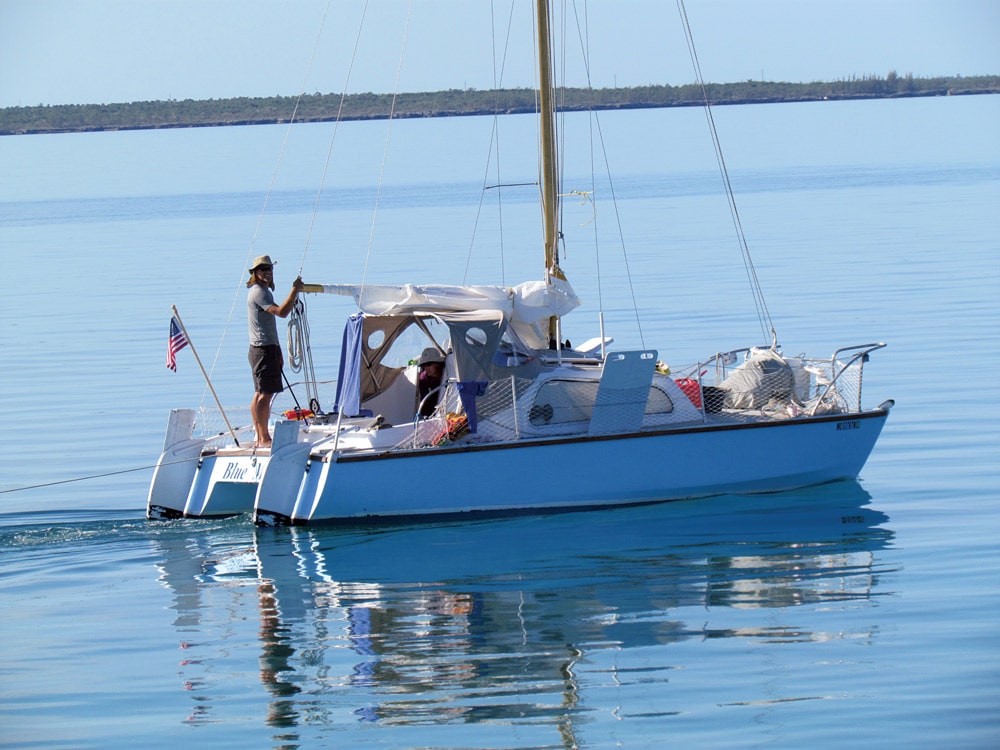
I flew to Florida and rendezvoused with family friends of Brian’s in Naples. They gave me the keys to his parents’ condo, where his van full of supplies and tools was stuffed in the garage. In the condo’s entryway, and along the garage walls, he’d stacked their winter supply of dried and canned food, his spare water jugs and gas cans.
It took me four long days to ready and launch Blue Moon. The first day was spent cleaning her — she’d been to Michigan and back on a trailer, and was covered in leaves and pine needles and road grime that had baked on in the Florida boatyard sun while the darker corners grew mold.
Once clean, I picked up where Brian left off. A lot of projects were left unfinished. I started with what I knew: I wired a small chart plotter and a cigarette lighter port. I installed the new-used Yamaha 9.9 outboard Brian had left in the van, built a new hatch cover for the port anchor locker out of a scrap of marine plywood and installed the composting toilet.
I worried that I was calling him too often: He was in Traverse City, maintaining a vigil I couldn’t comprehend. Abby was home, mostly in bed, and there was talk of calling in hospice. But he seemed to like the boat talk. It was a rare distraction, and over the past decade, we’d talked boats over the telephone while he stood in hospital waiting rooms, or holed up in a hotel room near a cancer center, or paced Detroit’s empty streets while Abby slept in recovery. He’d coached me through the purchase and rebuild of my boat, the essence of his encouragement always being an indefatigable sense of fearlessness. Never mind that I had little money. Get a boat. Never mind that I barely knew how to sail. Get a boat. Never mind that I didn’t even have a place to live. Get a boat. Live on it. Just do it. Life is short, time precious.
And I did, and I would not have if not for Brian.
Many of the things I stowed aboard Blue Moon belonged to Abby. I glimpsed her bathing suit within a clear plastic box. Her dive gear. Her sun hat. Her binoculars and bird guide. Her handwriting was on the labels as I stuffed the hulls of the little boat, and I tried not to picture the scene Brian and the kids were going to arrive to after their wife and mother was gone.
I got the boat stocked, begged help to step the mast and finally launched her. I called Brian when Blue Moon was afloat, and he said that he was lucky for this time with his wife, that he and Abby were able to say their goodbyes, were able to have all the talks they needed. I sat in the cockpit of his boat, looking at all of the work he’d done to prepare Blue Moon for his family’s vacation, and I tried to put myself in his shoes, tried to comprehend the pain and fear and emptiness, but ultimately all I could do was realize the incomprehensibility of what he faced.
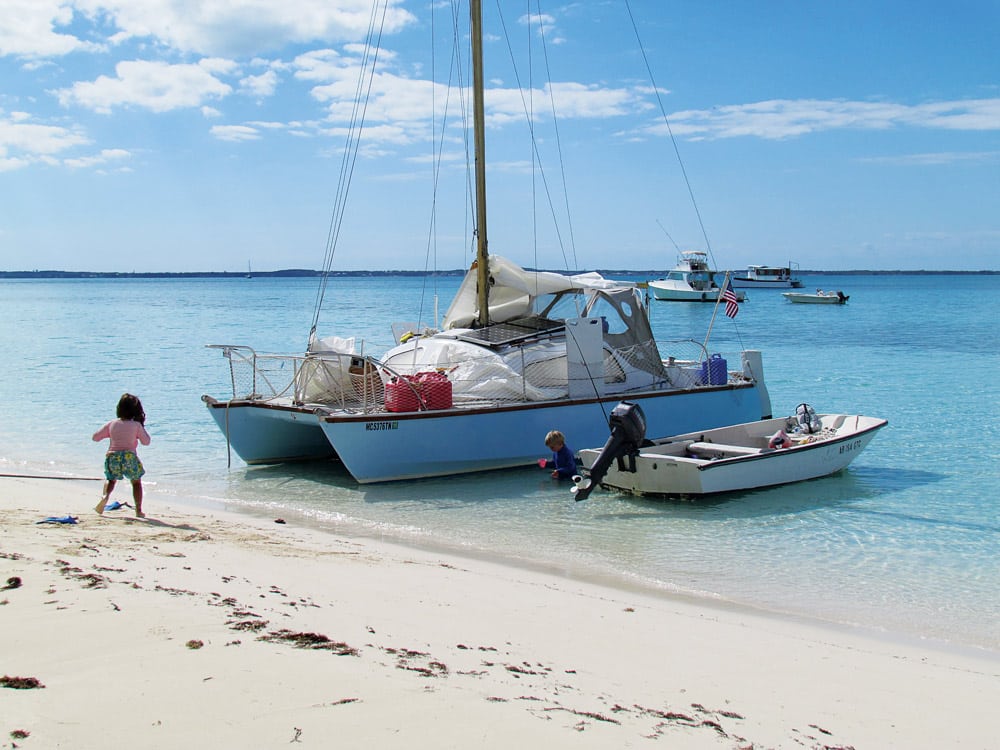
Then came the weather. Blue Moon is 23 feet long, and needed a window of calm to cross the Gulf Stream, and the weather that winter hadn’t been providing those openings. The 10-day forecast worsened with each new day.
My plan had been to motor across the Okeechobee Waterway from Fort Myers to Stuart, then cross from Lake Worth to the Bahama Bank, but with 10 days of north winds, it didn’t look like I’d cross anytime soon. On the phone, Brian told me that I had plenty of time, so I might as well enjoy myself. Sail south around the Keys, he said, then back up the east coast to Lake Worth.
I left the boatyard in Port Charlotte and motored down the long stretches of canals that filtered toward the sea, and I spent my first night aboard anchored near the lock that would, the next morning, spit me out into Gasparilla Bay. From that canal, I called my friend Josh in Montana, and told him the situation. Two days later, I picked him and his wife up in Fort Myers, and we started south in Blue Moon.
I stuffed myself into the starboard aft cocoonlike berth and gave Josh and Shannon the “master bed” in the bridge. It was a tight fit, similar to sharing a backpacking tent. Neither of them had sailed before, but both were adaptable and outdoor-oriented, and we’d been in plenty of odd places together, from the Utah deserts to the Alaskan tundra.

Nevertheless, I was nervous about getting Brian’s boat to him in one piece. I’d gotten it in my head that if something went wrong on Blue Moon, if something broke, it would be catastrophic for him. From my vantage point, the only thing keeping him afloat in the time surrounding his wife’s death was this little boat that was now my responsibility.
With north winds perhaps too good, we had a fast run south to Marco Island and into the Ten Thousand Islands, then worked east through the mangrove keys. I became obsessed with anchoring, envisioning the hook dragging, the boat piling in the surf. I set an alarm and woke each time the wind or tide shifted. I didn’t allow the boat out of my sight when we landed on the little beaches in the islands, despite the fact that if ever there was a boat easy on anchor, this was it. The Hirondelle was perfect for the Ten Thousand Islands. She drew about a foot of water, sipped gas and was light enough that we could nose the bow up onto a beach and jump onto the sand.
We spent four nights in the islands, including a visit to Everglades City, then holed up off Cape Sable in a nasty easterly blow. We tried once to leave but got turned back in a rainsquall so blinding that I couldn’t see the chart plotter in front of my face. Finally, we shot across to Little Pine Key, and ran south for Key West with following seas that lifted and rolled the small boat.
We had two nights in Key West before Josh and Shannon flew home, despite my protests. Then, a round of heavy north wind and rain kept me pinned aboard, the harbor too rough for the little dinghy. I spent three days waiting, then I went for it.
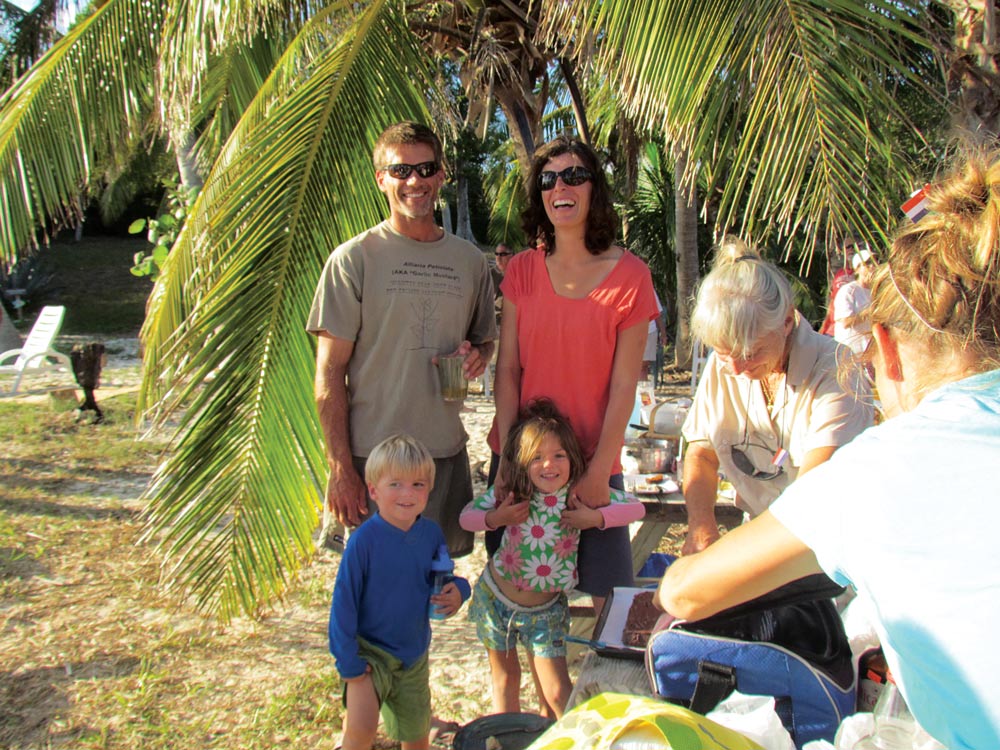
The 10-day forecast was still bad. I’d entertained notions of crossing the Stream from the Keys, heading for Bimini or around to George Town, but not when it was blowing 15-plus knots out of the north every day.
Instead, it was a rough chug northward, dead into the wind and sea, the deck awash with each surge, the bridgedeck pounding with each wave that passed between the hulls. I anchored at Little Torch Key, then Long Key, then ducked below the Channel 5 Bridge and dropped into the calm, green waters of Florida Bay.
By that point, Brian and I had changed plans. His kids would stay with his parents at the condo, and he and I would get Blue Moon to the Bahamas. I picked him up at Key Largo. He was frazzled, shocked and ready to leave the hardships of dry land.
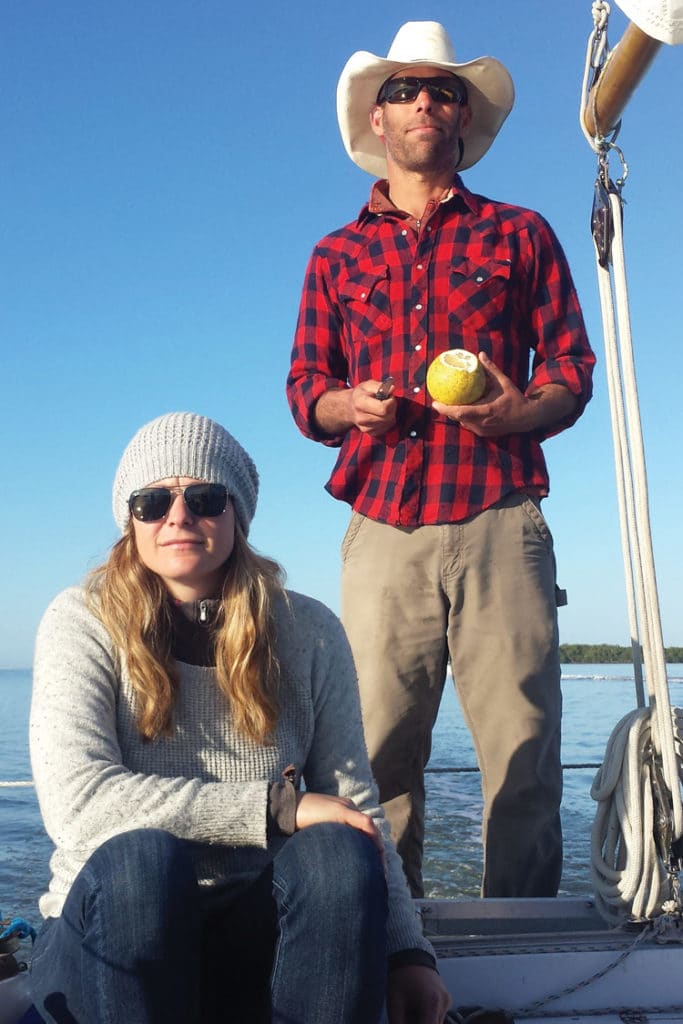
The weather was still cold, the wind still pushing out of the north. We poked our way up the Florida Intracoastal Waterway. We stopped here and there for burgers and beers, spent hours in silence and other hours talking about death, about how it is one goes on living when the other is gone.
When we reached Lake Worth, he rented a car and drove to Naples to be with his kids at his parents’ condo. I stayed aboard, waiting for good weather. It had been three weeks since I first scrubbed Michigan pine needles from Blue Moon‘s decks, and there hadn’t been a window for crossing the Stream yet.
But eventually, our fortunes changed and we got the weather we’d been waiting for. It wasn’t great, but it was doable. Brian said goodbye to his kids — he’d fly back from the Bahamas to get them — and returned his car. We made a last run to the grocery store, pulled anchor in the dark and motored through the steep swell of the Lake Worth Inlet.
The first half of the crossing was rough; Blue Moon tossed on all quarters, but sometime after noon, the Gulf Stream smoothed out, and that night we glided onto the Little Bahama Bank, the dark, deep waters of the Stream suddenly turning shallow and translucent in the moonlight.
“We’re in the Bahamas!” Brian yelled, holding his hands in the air, his fists clenched tight.
I looked around. We were alone out there. Nothing but Blue Moon and the sea bottom shining blue beneath the moon. This wasn’t the trip he’d counted on. His wife wasn’t aboard, and would never be aboard again, but as I watched him standing in the cockpit with his arms bent and his fists lifted, I understood that with his boat on the water, solace was at least possible.
A writer, commercial fisherman and former Montana guide, Jon Keller divides his time between his sailboat and his Down East Maine cabin. His first novel, Of Sea and Cloud, was published in 2014.








